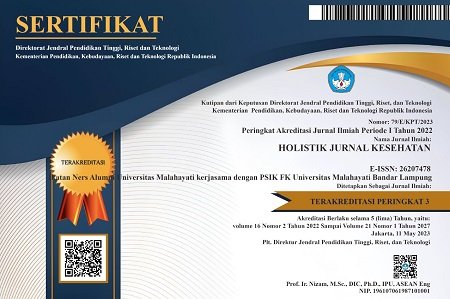HUBUNGAN ANTARA KEPRIBADIAN TIPE D DAN FAKTOR FISIOLOGI DENGAN VITAL EXHAUSTION PADA PASIEN INFARK MIOKARD
Abstract
Full Text:
PDFReferences
Bages, N., Appels, A., & Falger, P.R.J. (1999).
Vital exhaustion as a risk factor of myocardial infarction: a case-control study in Venezuela. International Journal of Behavioral Medicine, 6(3), 279-290. Bryant, M.J., Stevens, J., Truesdale, K.P., Mosley, T. & Chambless, L. (2008).
Obesity and vital exhaustion: analysis of the Atherosclerosis Risk in the Communities study. Obesity a research journal (2008) 16 (7), 1545–1551. Denollet, J., & Brutsaert, D.L (1998).
Personality, Disease Severity, and the Risk of Long-term Cardiac Events in Patients with a Decreased Ejection Fraction After Myocardial Infarction. Circulation 1998;97;167-173 American Heart Association Inc. Denolet, J., Vaes, J., & Brusaert, D.L. (2000).
Inadequate response to treatment in coronary heart disease: Adverse effects of type-D personality and younger age on 5-prognosis and quality of life. Circulation: journal of the American Heart Association, 2000;
;630-635. El-Mokadem, N. (2003) The relationship between
fatigue, depression, and sleep disturbance after MI. Ann Arbon: ProQuest Information and Learning company. Gallacher, E.J., Sweetnam, P.M., Yarnell, M & Elwood, P.C. (2003).
Is type A beha really a trigger for coronary heart ev Psychosomatic medicine. 65:339 American Psychosomatic Society. Gray, H.H., Dawkins, Morgan, & Simp (2002) Lecture notes: Kardiologi, bahasa oleh Azwar Agoes dan Rachmawati, 2005, Surabaya: Pen Airlangga. Inatavicius, D.D. (2006).
Interventions for cl with malnutrition and obesity, d Inatavicius, D.D. & Workman, ML.( Medical surgical nursing: critical thin for caollaborative care. (hlm. 839 St.Louis: Elsevier Saunders. Ivanusa, M., & Ivanusa, Z. (2004).
Risk fa and in-hospital outcomes in stroke myocardial infarction patients. Mic Central Public Health. 2004;4:26 Jenamonod, P., von Kanel, R., Maly, F.E Fischer, J.E. (2004).
Elevated plasm reactive protein in chronically distre subjects who Carry the a allele of the Ti -308G/A polymorphism. Psychoson Medicine 66:501-506 (2004) 0 3174/04/6604-0501. Jurnal Kesehatan Holistik Kilbourn, K., Saab, P., & Schneiderman, N. (2000).
Depression and negative affect in post-myocardial infaction patient: assessment and treatment implication dalam Johnson, S.L., Yahes, A.M., Field, T.M., Schneiderman, N.,& McCabe, P.M (Eds). Stress, coping, and depression. (hlm 265 270).Lawrence Erlbaum Associates. Koertge, J. (2003).
Vital exhaustion and coronary artery disease in women: Biological correlates and behavioral intervention. Thesis. Sweden, Stocholm: Karolinska University Press. ISBN Koertge, J.C., Ahnve, S., Schenck-Gustafsson, K., Orth-Gomer, K.,& Wamala, S.P. (2003).
Vital exhaustion in relation to lifestyle and lipid profile in healthy women. Int J Behav Med. 10 (1):44-45. Kop, W. J., Appels, A.P.W.M., Mendes, C.F.,
Swart, H.B., & Bar, F.W. (1994).
Vital exhaustion predicts new cardiac after successful coronaryangioplasty, dalam Psychosomatic medicine 56: 282-287 hlm.
The American psycomatic society. Lemone, P., & Burke, K.M. (2008).
Medical surgical nuring: critical thinking in client care. Philadelphia, New Jersy: Pearson education inc. Levine, B.S., (2005).
History taking and physical examination dalam Woods, S.L, Froelicher, E.S., Mtzer, S.A., & Bridges, E.J.(Eds), Cardiac nursing (5th ed.), (hlm 229-295). Philadelphia: Lippincott William & Wilkins. Ludington, A., & Diehl, H. (2002).
Dynamic living. Loma Linda, California. Lifestyle Medicine Institute. Madan, S.K., & Froelicher, E.S. (2005).
Psychosocial risk factors: assessment and management dalam Woods, S.L, Erika S.R, Motzer, S.A., and Bridges, E.J.(Eds) Cardiac nursing (5th ed). (Hlm.809 824).Philadelphia: Lippincott Williams & Wilkins. Newton, K.M., & Froelicher, E.S. (2005).
Coronary heart disease risk factors dalam Woods, S.L, Erika S.R, Motzer, S.A., & Bridges, E.J. Cardiac nursing (5th ed.), (Hlm.809-824). Philadelphia: Lippincott Williams & Wilkins. Pedersen, S.S., Lemon, P.A., van Vooren, P.R., Liu, T.K., Daemen, J., Erdman, R.A., Smits, P.C., Serruys, P.W.J.C., & van Domburg, R.T., (2004).
Type D personality predicts death or myocardial infarction after bare metal stent or sirolimus-eluting stent implantation: a Rapamycin-Eluting Stent Evaluated at Rotterdam Cardiology Hospital (RESEARCH) registry substudy. Journal of the Amrican Colegeofl Cardiology. 2004 Sep
;44(5):997-1001.Elsevier Inc. Pedersen, S.S., Daemen, J., van de Sande, M., Sonnenschein, K., , Serruys, P.W., Erdman, R.A.M., & van Domburg, R.T. ( 2007).
Type-D personality exerts a stable,adverse effect on vital exhaustion in PCI patients treated with paclitaxel-eluting stents Journal of Psychosomatic Research 62 (2007) 447 453 Popelka, K., A. (2005).
Assessment of the cardiac system dalam Black, J.M dan Hawks, J.H. Medical surgical nursing: clinical management fro positive outcome. (7th ed.) (hlm. 1560-1598). St. Louis, Missouri: Elsevier Saunders. Prescott, E., Holst, C., Gronbaek, M., Schnohr, P., Jensen, G., & Barefoot, J. (2003).
Vital exhaustion as. A risk factor for ischaemic heart disease and all-cause mortality in a community sample. A prospective study of 4080 men and 5479 women in the Copenhagen City Heart Study, International
Journal of Epidmiology , 990-997. Rahayu, U., Nurachmah, E., & Gayatri, D. (2008).
Faktor-faktor yang berhubungan dengan vital exhaustion pada pasien penyakit jantung koroner (PJK) di RSU. Cibabat Cimahi dan RS Rajawali Bandung. Tesis (tidak dipublikasikan). Program Pasca Sarjana Fakultas Ilmu Keperawatan Universitas Indonesia. Raikkonen, K. (1997).
Vital exhaustion- a syndrome of psychological distress, dalam John, D.,& MacArthur, C.T. 126
DOI: https://doi.org/10.33024/hjk.v5i1.869
Refbacks
- There are currently no refbacks.
Copyright (c) 2019 HOLISTIK JURNAL KESEHATAN

This work is licensed under a Creative Commons Attribution-NonCommercial 4.0 International License.














